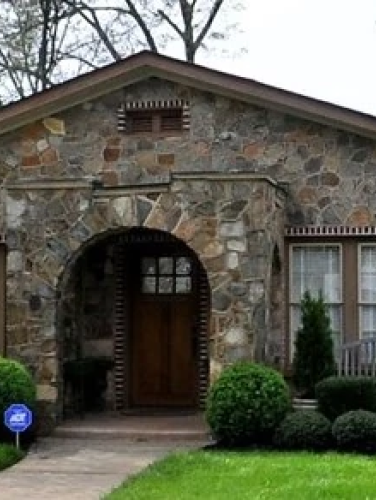
Calvin Neal House
(ca. 1927)
The Calvin Neal House is a rare early example of stone rubble construction and the only one of its kind in Wesley Heights.
612 and 614 Walnut Ave., Charlotte, NC 28208
The only stone house in the Wesley Heights neighborhood, the Calvin Neal House is a rare and well-preserved example of early stone rubble veneer construction in Charlotte. The house, one of only some twenty-two rubble stone veneer houses built in the city between 1920 and the early 1940s, is an unusual mix of architectural detailing. Unlike most of its stone contemporaries, every major exterior feature of the house (including its portico and porte-cochere) is covered entirely in fieldstone. Developed in the 1920s, Wesley Heights is otherwise characterized by its homogenous housing stock, making the Calvin Neal House a unique testament to the high level of craftsmanship possible in what would otherwise be considered a common vernacular structure.
Property Quick Links
Suburbs like Wesley Heights that developed in the 1920s tended to be strictly residential, segregated by economic class, and more dependent upon the automobile than the streetcar like Charlotte’s earlier suburbs. Deed covenants regulating setback, fencing, cost of construction, and other variables assured that the entire suburb would maintain some degree of cohesion. Such precautions, coupled with the neighborhood’s relatively rapid development and the growing middle class preference for stock house plans rather than architect-designed homes, gave Wesley Heights a more homogenous streetscape than the city’s earlier neighborhoods. Wesley Heights was made up almost exclusively of similar looking bungalows, Tudor Revival cottages, and Colonial Revival homes of brick and wood.
It was during this period that Calvin Neal and his wife Margaret bought the Walnut Avenue lot. Both natives of Charlotte, Calvin had worked his way from meter-reader to bookkeeper and accountant at the Southern Power and Utilities Company (later renamed Duke Power) during the 1920s while Margaret worked as a clerk for Efird’s department store. To make their home distinctive from Wesley Heights’ repetitive rows of brick Colonials and frame bungalows, Calvin Neal had the house clad entirely in rustic rubble fieldstone.
At that time, stone was generally regarded as a costly and extravagant building material meant primarily for imposing civic and commercial structures rather than residential buildings. The Arts and Crafts Movement, with its emphasis on local and natural building materials, had popularized the use of stone for residential areas, but usually only as a decorative accent on porches and chimneys. Brick and wood were cheaper, easier to use, and more readily available. The Neal house is an unusual example of a type of construction rarely seen in Charlotte. Within the context of the then-conservative white-collar Wesley Heights neighborhood, the house’s exuberant rubble façade breaks through the suburb’s uniformity.

